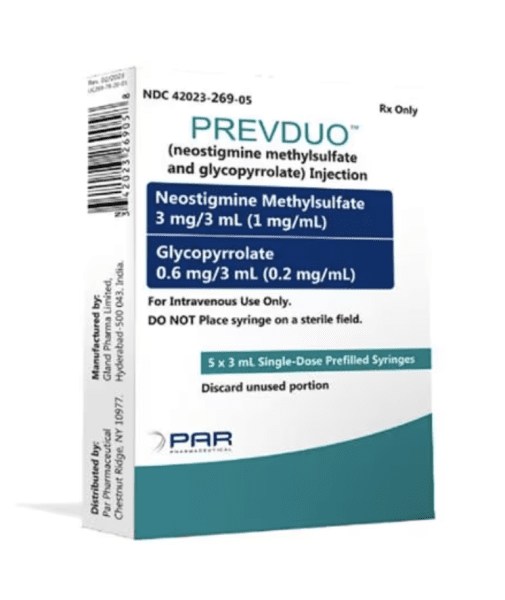Glycopyrrolate / neostigmine Side Effects
Medically reviewed by Drugs.com. Last updated on Jan 27, 2024.
Applies to glycopyrrolate / neostigmine: intravenous solution.
Serious side effects
Along with its needed effects, glycopyrrolate/neostigmine may cause some unwanted effects. Although not all of these side effects may occur, if they do occur they may need medical attention.
Check with your doctor or nurse immediately if any of the following side effects occur while taking glycopyrrolate / neostigmine:
Less common
- Blurred vision
- change in color vision
- chest pain, discomfort, or tightness
- confusion
- cough
- decrease in frequency of urination
- decrease in urine volume
- difficult and painful urination
- difficulty in passing urine [dribbling]
- difficulty seeing at night
- dizziness, faintness, or lightheadedness when getting up suddenly from a lying or sitting position
- dry mouth
- excitement
- fast, pounding, or irregular heartbeat or pulse
- headache
- hives, itching, skin rash
- increased sensitivity of eyes to sunlight
- mental confusion
- pale skin
- puffiness or swelling of the eyelids or around the eyes, face, lips, or tongue
- sleeplessness
- slow or irregular heartbeat
- sweating
- thirst
- trouble breathing
- trouble sleeping
- unusual tiredness or weakness
Incidence not known
- Constricted, pinpoint, or small pupils [black part of the eye]
- diarrhea
- high fever
- loss of consciousness
- no blood pressure or pulse
- no breathing
- noisy breathing
- pale or blue lips, fingernails, or skin
- rigid muscles
- seizures
- sleepiness
- stopping of the heart
- unconsciousness
Other side effects
Some side effects of glycopyrrolate / neostigmine may occur that usually do not need medical attention. These side effects may go away during treatment as your body adjusts to the medicine. Also, your health care professional may be able to tell you about ways to prevent or reduce some of these side effects.
Check with your health care professional if any of the following side effects continue or are bothersome or if you have any questions about them:
Less common
- Bloated
- constipation
- dry skin
- loss of taste
- nausea
- vomiting
Incidence not known
- Difficulty in moving
- excess air or gas in the stomach or intestines
- feeling of warmth
- full feeling
- increased sweating
- joint pain
- muscle pain, stiffness, cramps, or spasms
- passing gas
- redness of the face, neck, arms and occasionally, upper chest
For Healthcare Professionals
Applies to glycopyrrolate / neostigmine: intravenous solution.
General
The most common adverse effects of glycopyrrolate (glycopyrronium) include xerostomia, urinary hesitancy and retention, blurred vision, and photophobia due to mydriasis, cycloplegia, increased ocular tension, tachycardia, bradycardia, and decreased sweating. The most common adverse effects of neostigmine are bradycardia, nausea, vomiting, blurred vision, and photophobia.[Ref]
Cardiovascular
Common (1% to 10%): Increased/decreased heart rate
Uncommon (0.1% to 1%): Supraventricular extrasystoles, ventricular extrasystoles (0.4%), procedural hypertension, chest discomfort, bradycardia, hypertension
Glycopyrrolate (glycopyrronium):
Frequency not reported: Tachycardia, palpitation
Postmarketing reports: Arrhythmias (including bradycardia, ventricular tachycardia, ventricular fibrillation), cardiac arrest, hypertension, hypotension, heart block, QTc interval prolongation
Neostigmine:
Frequency not reported: Bradycardia, hypotension, tachycardia/increased heart rate
Postmarketing reports: Cardiac arrest, cardiac arrhythmias (A-V block, nodal rhythm), hypotension, nonspecific electrocardiogram (EKG) changes, syncope[Ref]
Dermatologic
Uncommon (0.1% to 1%): Hyperhidrosis, erythema, pruritus
Glycopyrrolate (glycopyrronium):
Frequency not reported: Decreased sweating, urticaria, pruritus, dry skin
Postmarketing reports: Pruritus, edema, erythema, pain at the injection site
Neostigmine:
Frequency not reported: Pruritus
Postmarketing reports: Rash, urticaria, flushing increased diaphoresis[Ref]
Gastrointestinal
Common (1% to 10%): Nausea, dry mouth
Uncommon (0.1% to 1%): Abdominal pain, dyspepsia, vomiting
Glycopyrrolate (glycopyrronium):
Frequency not reported: Xerostomia, nausea, vomiting, constipation, bloated feeling
Neostigmine:
Frequency not reported: Dry mouth, nausea, post-procedural nausea, vomiting, increased salivation
Postmarketing reports: Bowel cramps, diarrhea, flatulence, increased peristalsis[Ref]
Musculoskeletal
Common (1% to 10%): Muscle weakness
Neostigmine:
Postmarketing reports: Arthralgia, muscle cramps, spasms, weakness[Ref]
Genitourinary
Glycopyrrolate (glycopyrronium):
Frequency not reported: Urinary hesitancy and retention, impotence, micturition urgency
Neostigmine:
Postmarketing reports: Urinary frequency[Ref]
Hepatic
Uncommon (0.1% to 1%): Increased glutamyl transferase[Ref]
Hypersensitivity
Glycopyrrolate (glycopyrronium):
Frequency not reported: Severe allergic reactions (including anaphylactic/anaphylactoid reactions), hypersensitivity
Neostigmine:
Postmarketing reports: Allergic reactions (including anaphylaxis), hypersensitivity, angioedema[Ref]
Nervous system
Uncommon (0.1% to 1%): Involuntary muscle contraction, somnolence, prolonged neuromuscular blockade
Frequency not reported: Confusion (especially in elderly adults)
Glycopyrrolate (glycopyrronium):
Frequency not reported: Loss of taste, headache, nervousness, drowsiness, dizziness
Neostigmine:
Frequency not reported: Dizziness, headache, prolonged neuromuscular blockade[Ref]
Ocular
Uncommon (0.1% to 1%): Visual accommodation disorder
Frequency not reported: Dilatation of the pupils, angle closure glaucoma
Glycopyrrolate (glycopyrronium):
Frequency not reported: Blurred vision, photophobia (due to mydriasis), cycloplegia, increased ocular tension[Ref]
Other
Uncommon (0.1% to 1%): Decreased blood total protein, increased urine beta 2 microglobulin, incision site complication
Glycopyrrolate (glycopyrronium):
Frequency not reported: Weakness, suppression of lactation
Postmarketing reports: Malignant hyperthermia
Neostigmine:
Frequency not reported: Procedural complication, procedural pain, incision site complication, postoperative shivering[Ref]
Psychiatric
Uncommon (0.1% to 1%): Restlessness, sleep disorder, dizziness
Glycopyrrolate (glycopyrronium):
Frequency not reported: Insomnia, mental confusion/excitement (especially in elderly adults)
Neostigmine:
Frequency not reported: Insomnia[Ref]
Renal
Uncommon (0.1% to 1%): Albuminuria[Ref]
Respiratory
Uncommon (0.1% to 1%): Productive cough
Glycopyrrolate (glycopyrronium):
Postmarketing reports: Respiratory arrest, decreased bronchial secretion
Neostigmine:
Frequency not reported: Pharyngolaryngeal pain, dyspnea, less than 90% oxygen desaturation, increased oropharyngeal secretion
Postmarketing reports: Bronchospasm (increased oral, pharyngeal, and bronchial secretions), respiratory arrest, respiratory depression[Ref]
More about glycopyrrolate / neostigmine
- Check interactions
- Compare alternatives
- Dosage information
- During pregnancy
- Drug class: antidotes
- En español
Patient resources
- Glycopyrrolate and neostigmine drug information
- Neostigmine methylsulfate and glycopyrrolate (Advanced Reading)
Other brands
Professional resources
Other brands
Related treatment guides
References
1. Product Information. Prevduo (glycopyrrolate-neostigmine). Slayback Pharma LLC. 2023.
2. Product Information. Novistig (glycopyrronium-neostigmine). Boucher & Muir Pty Ltd. 2019.
3. Product Information. Robinul-Neostigmine (glycopyrronium-neostigmine). Advanz Pharma. 2019.
Further information
Always consult your healthcare provider to ensure the information displayed on this page applies to your personal circumstances.
Some side effects may not be reported. You may report them to the FDA.

